1、供应链管理(2)
- 格式:ppt
- 大小:383.00 KB
- 文档页数:17

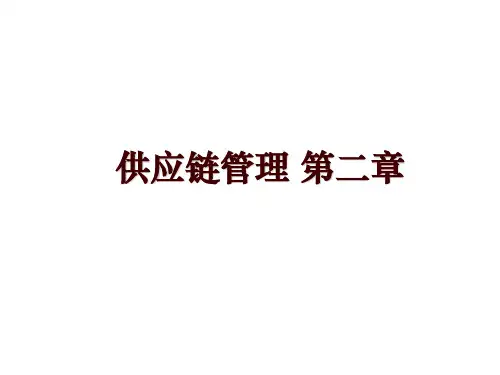
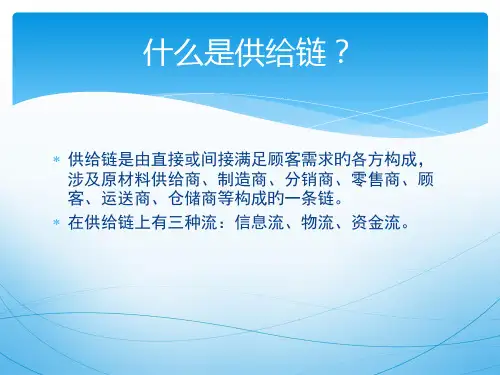
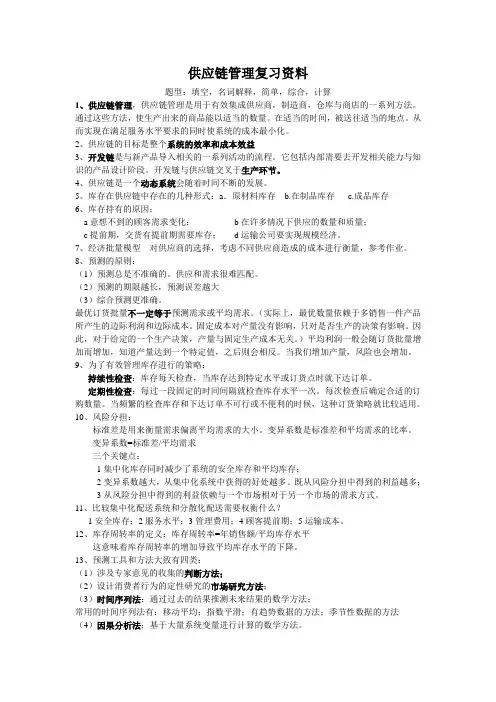
供应链管理复习资料题型:填空,名词解释,简单,综合,计算1、供应链管理,供应链管理是用于有效集成供应商,制造商,仓库与商店的一系列方法。
通过这些方法,使生产出来的商品能以适当的数量。
在适当的时间,被送往适当的地点。
从而实现在满足服务水平要求的同时使系统的成本最小化。
2、供应链的目标是整个系统的效率和成本效益3、开发链是与新产品导入相关的一系列活动的流程。
它包括内部需要去开发相关能力与知识的产品设计阶段。
开发链与供应链交叉于生产环节。
4、供应链是一个动态系统会随着时间不断的发展。
5、库存在供应链中存在的几种形式:a.原材料库存 b.在制品库存 c.成品库存6、库存持有的原因:a意想不到的顾客需求变化;b在许多情况下供应的数量和质量;c提前期,交货有提前期需要库存;d运输公司要实现规模经济。
7、经济批量模型---对供应商的选择,考虑不同供应商造成的成本进行衡量,参考作业。
8、预测的原则:(1)预测总是不准确的。
供应和需求很难匹配。
(2)预测的期限越长,预测误差越大(3)综合预测更准确。
最优订货批量不一定等于预测需求或平均需求。
(实际上,最优数量依赖于多销售一件产品所产生的边际利润和边际成本。
固定成本对产量没有影响,只对是否生产的决策有影响。
因此,对于给定的一个生产决策,产量与固定生产成本无关。
)平均利润一般会随订货批量增加而增加,知道产量达到一个特定值,之后则会相反。
当我们增加产量,风险也会增加。
9、为了有效管理库存进行的策略:持续性检查:库存每天检查,当库存达到特定水平或订货点时就下达订单。
定期性检查:每过一段固定的时间间隔就检查库存水平一次。
每次检查后确定合适的订购数量。
当频繁的检查库存和下达订单不可行或不便利的时候,这种订货策略就比较适用。
10、风险分担:标准差是用来衡量需求偏离平均需求的大小。
变异系数是标准差和平均需求的比率。
变异系数=标准差/平均需求三个关键点:1集中化库存同时减少了系统的安全库存和平均库存;2变异系数越大,从集中化系统中获得的好处越多。
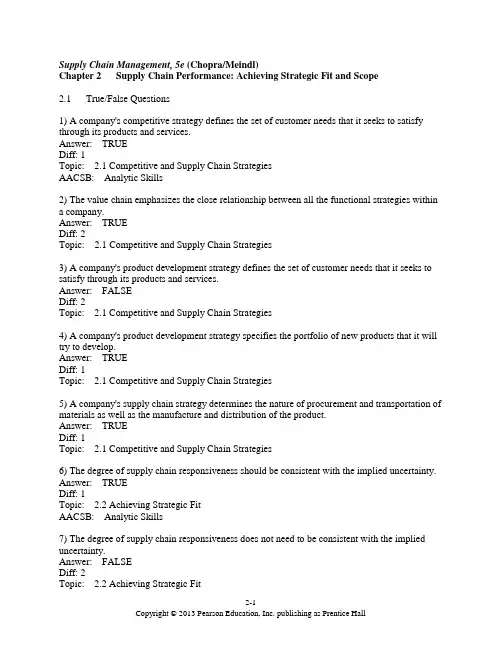
Supply Chain Management, 5e (Chopra/Meindl)Chapter 2 Supply Chain Performance: Achieving Strategic Fit and Scope2.1 True/False Questions1) A company's competitive strategy defines the set of customer needs that it seeks to satisfy through its products and services.Answer: TRUEDiff: 1Topic: 2.1 Competitive and Supply Chain StrategiesAACSB: Analytic Skills2) The value chain emphasizes the close relationship between all the functional strategies withina company.Answer: TRUEDiff: 2Topic: 2.1 Competitive and Supply Chain Strategies3) A company's product development strategy defines the set of customer needs that it seeks to satisfy through its products and services.Answer: FALSEDiff: 2Topic: 2.1 Competitive and Supply Chain Strategies4) A company's product development strategy specifies the portfolio of new products that it will try to develop.Answer: TRUEDiff: 1Topic: 2.1 Competitive and Supply Chain Strategies5) A company's supply chain strategy determines the nature of procurement and transportation of materials as well as the manufacture and distribution of the product.Answer: TRUEDiff: 1Topic: 2.1 Competitive and Supply Chain Strategies6) The degree of supply chain responsiveness should be consistent with the implied uncertainty. Answer: TRUEDiff: 1Topic: 2.2 Achieving Strategic FitAACSB: Analytic Skills7) The degree of supply chain responsiveness does not need to be consistent with the implied uncertainty.Answer: FALSEDiff: 2Topic: 2.2 Achieving Strategic Fit8) To achieve complete strategic fit, a firm must ensure that all functions in the value chain have consistent strategies that support the competitive strategy.Answer: TRUEDiff: 2Topic: 2.2 Achieving Strategic Fit9) To achieve complete strategic fit, a firm must ensure that all functions in the value chain have diverse strategies that support functional goals.Answer: FALSEDiff: 2Topic: 2.2 Achieving Strategic Fit10) Because demand and supply characteristics change, the supply chain strategy must change over the product life cycle if a company is to continue achieving strategic fit.Answer: TRUEDiff: 1Topic: 2.2 Achieving Strategic Fit11) To retain strategic fit, supply chain strategy must be adjusted over the life cycle of a product and as the competitive landscape changes.Answer: TRUEDiff: 2Topic: 2.2 Achieving Strategic Fit12) The intercompany scope of strategic fit is no longer relevant today because the competitive playing field has shifted from company versus company to supply chain versus supply chain. Answer: FALSEDiff: 1Topic: 2.2 Achieving Strategic Fit13) A company will fail if there is a lack of strategic fit or because its overall supply chain design, processes, and resources do not provide the capabilities to support the maximum strategic fit.Answer: FALSEDiff: 3Topic: 2.2 Achieving Strategic FitAACSB: Analytic Skills14) The following situation would likely work well. A situation in which marketing is publicizing a company's ability to provide a large variety of products very quickly; simultaneously, distribution is targeting the lowest cost means of transportation.Answer: FALSEDiff: 1Topic: 2.2 Achieving Strategic FitAACSB: Reflective Thinking Skills15) Supply chain strategy specifies what the operations, distribution, and service functions, whether performed in-house or outsourced, should do particularly well.Answer: TRUEDiff: 1Topic: 2.1 Competitive and Supply Chain StrategiesAACSB: Analytic Skills2.2 Multiple Choice Questions1) A company's competitive strategyA) defines the set of customer needs that it seeks to satisfy through its products and services.B) specifies the portfolio of new products that it will try to develop.C) specifies how the market will be segmented and how the product will be positioned, priced, and promoted.D) determines the nature of procurement and transportation of materials as well as manufacture and distribution of the product.E) determines how it will obtain and maintain the appropriate set of skills and abilities to meet customer needs.Answer: ADiff: 2Topic: 2.1 Competitive and Supply Chain StrategiesAACSB: Reflective Thinking Skills2) A company's product development strategyA) defines the set of customer needs that it seeks to satisfy through its products and services.B) specifies the portfolio of new products that it will try to develop.C) specifies how the market will be segmented and how the product will be positioned, priced, and promoted.D) determines the nature of procurement and transportation of materials as well as manufacture and distribution of the product.E) determines how it will obtain and maintain the appropriate set of skills and abilities to meet customer needs.Answer: BDiff: 1Topic: 2.1 Competitive and Supply Chain Strategies3) A company's marketing and sales strategyA) defines the set of customer needs that it seeks to satisfy through its products and services.B) specifies the portfolio of new products that it will try to develop.C) specifies how the market will be segmented and how the product will be positioned, priced, and promoted.D) determines the nature of procurement and transportation of materials as well as manufacture and distribution of the product.E) determines how it will obtain and maintain the appropriate set of skills and abilities to meet customer needs.Answer: CDiff: 2Topic: 2.1 Competitive and Supply Chain Strategies4) A company's supply chain strategyA) defines the set of customer needs that it seeks to satisfy through its products and services.B) specifies the portfolio of new products that it will try to develop.C) specifies how the market will be segmented and how the product will be positioned, priced, and promoted.D) determines the nature of procurement and transportation of materials as well as manufacture and distribution of the product.E) determines how it will obtain and maintain the appropriate set of skills and abilities to meet customer needs.Answer: DDiff: 1Topic: 2.1 Competitive and Supply Chain Strategies5) Which of the following determines the nature of procurement of raw materials, transportation of materials to and from the company, manufacture of the product or operation to provide the service, and distribution of the product to the customer along with follow-up service?A) Competitive strategyB) Product development strategyC) Marketing and sales strategyD) Supply chain strategyE) none of the aboveAnswer: DDiff: 1Topic: 2.1 Competitive and Supply Chain Strategies6) Which of the following defines the set of customer needs that a company seeks to satisfy through its products and services?A) Competitive strategyB) Product development strategyC) Marketing and sales strategyD) Supply chain strategyE) none of the aboveAnswer: ADiff: 2Topic: 2.1 Competitive and Supply Chain Strategies7) Which of the following specifies the portfolio of new products that a company will try to develop?A) Competitive strategyB) Product development strategyC) Marketing and sales strategyD) Supply chain strategyE) all of the aboveAnswer: BDiff: 1Topic: 2.1 Competitive and Supply Chain Strategies8) A supply chain strategy involves decisions regardingA) inventory.B) transportation.C) operating facilities.D) information flows.E) all of the aboveAnswer: EDiff: 2Topic: 2.1 Competitive and Supply Chain Strategies9) A supply chain strategy involves decisions regarding all of the following exceptA) inventory.B) transportation.C) new product development.D) operating facilities.E) information flows.Answer: CDiff: 2Topic: 2.1 Competitive and Supply Chain Strategies10) Which of the following is not a key to the success or failure of a company?A) The competitive strategy and all functional strategies must fit together to form a coordinated overall strategy.B) The competitive strategy and all functional strategies operate independently of each other.C) The different functions in a company must appropriately structure their processes and resources to be able to execute strategies successfully.D) Each functional strategy must support other functional strategies and help a firm reach its competitive strategy goal.E) All of the above are keys to success.Answer: BDiff: 2Topic: 2.2 Achieving Strategic Fit11) Which of the following are basic steps to achieving strategic fit?A) Understanding the customer and supply uncertainty.B) Understanding the supply chain capabilities.C) Achieving strategic fit.D) All of the above are basic steps to achieving strategic fit.E) None of the above are a basic step to achieving strategic fit.Answer: DDiff: 2Topic: 2.2 Achieving Strategic FitAACSB: Analytic Skills12) The uncertainty of customer demand for a product is theA) rate of strategic uncertainty.B) demand uncertainty.C) implied demand uncertainty.D) average forecast error.E) none of the aboveAnswer: BDiff: 2Topic: 2.2 Achieving Strategic FitAACSB: Analytic Skills13) The uncertainty that exists due to the portion of demand that the supply chain is required to meet is theA) rate of strategic uncertainty.B) demand uncertainty.C) implied demand uncertainty.D) average forecast error.E) none of the aboveAnswer: CDiff: 2Topic: 2.2 Achieving Strategic FitAACSB: Analytic Skills14) Which of the following customer needs will cause implied uncertainty of demand to decrease?A) Range of quantity required increasesB) Lead time decreasesC) Variety of products required increasesD) Required service level increasesE) none of the aboveAnswer: EDiff: 2Topic: 2.2 Achieving Strategic Fit15) Which of the following customer needs will cause implied uncertainty of demand to increase?A) Product marginB) Lead time decreasesC) Average stockout rateD) Average forced season end markdownE) none of the aboveAnswer: BDiff: 2Topic: 2.2 Achieving Strategic FitAACSB: Analytic Skills16) Which of the following is not a characteristic of customer demand correlated with implied uncertainty?A) Product marginB) Unpredictable and low yieldsC) Average stockout rateD) Average forced season end markdownE) None of the above are correlated with implied uncertainty.Answer: BDiff: 2Topic: 2.2 Achieving Strategic Fit17) Which of the following is not a supply chain capability that will impact supply uncertainty?A) Evolving production processB) Inflexible supply capacityC) Limited supply capacityD) Product marginE) Unpredictable and low yieldsAnswer: DDiff: 2Topic: 2.2 Achieving Strategic Fit18) The first step in achieving strategic fit between competitive and supply chain strategies is toA) understand the supply chain and map it on the responsiveness spectrum.B) understand customers and supply chain uncertainty.C) match supply chain responsiveness with the implied uncertainty of demand.D) ensure that all functional strategies within the supply chain support the supply chain's level of responsiveness.E) none of the aboveAnswer: BDiff: 3Topic: 2.2 Achieving Strategic Fit19) The second step in achieving strategic fit between competitive and supply chain strategies is toA) understand the supply chain and map it on the responsiveness spectrum.B) understand customers and supply chain uncertainty.C) match supply chain responsiveness with the implied uncertainty of demand.D) ensure that all functional strategies within the supply chain support the supply chain's level of responsiveness.E) none of the aboveAnswer: ADiff: 3Topic: 2.2 Achieving Strategic Fit20) The final step in achieving strategic fit between competitive and supply chain strategies is toA) understand the supply chain and map it on the responsiveness spectrum.B) understand customers and supply chain uncertainty.C) match supply chain responsiveness with the implied uncertainty of demand.D) combine customer and supply chain uncertainty and map it on the implied uncertainty spectrum.E) all of the aboveAnswer: CDiff: 2Topic: 2.2 Achieving Strategic FitAACSB: Analytic Skills21) Supply chain responsiveness includes the ability to do which of the following?A) Handle supply uncertaintyB) Understand customers and supply chain uncertaintyC) Match supply chain responsiveness with the implied uncertainty of demandD) Ensure that all functional strategies within the supply chain support the supply chain's level of responsivenessE) none of the aboveAnswer: ADiff: 2Topic: 2.2 Achieving Strategic Fit22) Supply chain responsiveness includes the ability to do which of the following?A) Understand customers and supply chainB) Meet a very high service levelC) Match supply chain responsiveness with the implied uncertainty of demandD) Ensure that all functional strategies within the supply chain support the supply chain's level of responsivenessE) none of the aboveAnswer: BDiff: 2Topic: 2.2 Achieving Strategic Fit23) Supply chain responsiveness includes the ability to do which of the following?A) Understand customers and supply chainB) Match supply chain responsiveness with the implied uncertainty of demandC) Meet short lead timesD) Ensure that all functional strategies within the supply chain support the supply chain's level of responsivenessE) all of the aboveAnswer: CDiff: 2Topic: 2.2 Achieving Strategic Fit24) The cost of making and delivering a product to the customer is referred to asA) supply chain responsiveness.B) supply chain efficiency.C) cost-responsiveness efficient frontier.D) implied uncertainty.E) none of the aboveAnswer: BDiff: 1Topic: 2.2 Achieving Strategic Fit25) The curve that shows the lowest possible cost for a given level of responsiveness is referred to as theA) supply chain responsiveness curve.B) supply chain efficiency curve.C) cost-responsiveness efficient frontier.D) responsiveness spectrum.E) none of the aboveAnswer: CDiff: 2Topic: 2.2 Achieving Strategic Fit26) A firm that is not on the cost-responsiveness efficient frontier can improveA) both responsiveness and cost performance.B) only responsiveness.C) only cost performance.D) responsiveness, but not cost performance.E) neither responsiveness nor cost performance.Answer: ADiff: 1Topic: 2.2 Achieving Strategic FitAACSB: Analytic Skills27) A graph with two axes with implied uncertainty along the horizontal axis and responsiveness along the vertical axis is referred to as theA) implied uncertainty spectrum.B) responsiveness spectrum.C) uncertainty/responsiveness map.D) zone of strategic fit.E) none of the aboveAnswer: CDiff: 2Topic: 2.2 Achieving Strategic Fit28) The relationship where increasing implied uncertainty from customers and supply sources is best served by increasing responsiveness from the supply chain is known as theA) implied uncertainty spectrum.B) responsiveness spectrum.C) uncertainty/responsiveness map.D) zone of strategic fit.E) none of the aboveAnswer: DDiff: 2Topic: 2.2 Achieving Strategic FitAACSB: Analytic Skills29) The drive for strategic fit should come fromA) the supply chain manager.B) the strategic planning department.C) the highest levels of the organization, such as the CEO.D) middle management.E) sales and marketing.Answer: CDiff: 3Topic: 2.2 Achieving Strategic Fit30) The important points to remember about achieving strategic fit areA) there is one best supply chain strategy for all competitive strategies.B) there is no right supply chain strategy independent of the competitive strategy.C) there is a right supply chain strategy for a given competitive strategy.D) all of the aboveE) B and C onlyAnswer: EDiff: 3Topic: 2.2 Achieving Strategic Fit31) The preferable supply chain strategy for a firm that sells multiple products and serves customer segments with very different needs is toA) set up independent supply chains for each different product or customer segment.B) set up a supply chain that meets the needs of the highest volume product or customer segment.C) tailor the supply chain to best meet the needs of each product's demand.D) set up a supply chain that meets the needs of the customer segment with the highest implied uncertainty.E) set up a supply chain that meets the needs of product with the highest implied uncertainty. Answer: CDiff: 3Topic: 2.2 Achieving Strategic Fit32) Which of the following would not be a demand and supply characteristic toward the beginning stages of a product's life cycle?A) Demand is very uncertain and supply may be unpredictable.B) Demand has become more certain and supply is predictable.C) Margins are often high and time is crucial to gaining sales.D) Product availability is crucial to capturing the market.E) Cost is often of secondary consideration.Answer: BDiff: 2Topic: 2.2 Achieving Strategic Fit33) Which of the following would be a demand and supply characteristic toward the beginning stages of a product's life cycle?A) Demand has become more certain and supply is predictable.B) Margins are lower due to an increase in competitive pressure.C) Product availability is crucial to capturing the market.D) Price becomes a significant factor in customer choice.E) none of the aboveAnswer: CDiff: 2Topic: 2.2 Achieving Strategic Fit34) Which of the following would not be a demand and supply characteristic in the later stages of a product's life cycle?A) Demand has become more certain and supply is predictable.B) Margins are lower due to an increase in competitive pressure.C) Product availability is crucial to capturing the market.D) Price becomes a significant factor in customer choice.E) All of the above are characteristics of the later stages.Answer: CDiff: 2Topic: 2.2 Achieving Strategic Fit35) The functions and stages that devise an integrated strategy with a shared objective are referred to asA) competitive strategy.B) supply chain strategy.C) scope of strategic fit.D) scope of marketing strategy.E) scope of product development strategy.Answer: CDiff: 2Topic: 2.3 Expanding Strategic Scope36) The value chain consists of direct and indirect activities. Which of the following is an indirect activity for an enterprise?A) MarketingB) DistributionC) Human ResourcesD) ServiceAnswer: CDiff: 3Topic: 2.1 Competitive and Supply Chain Strategies37) A ________ strategy specifies the portfolio of new products that a company will try to develop.A) Product DevelopmentB) Marketing and SalesC) Supply ChainD) FinanceAnswer: ADiff: 2Topic: 2.1 Competitive and Supply Chain Strategies38) A ________ strategy specifies how the market will be segmented and how the product will be positioned, priced, and promoted.A) Product DevelopmentB) Marketing and SalesC) Supply ChainD) FinanceAnswer: BDiff: 2Topic: 2.1 Competitive and Supply Chain Strategies39) Between 1993 and 2006, Dell's competitive strategy was to provide a large variety of customizable products at a reasonable price. Given the focus on customization, Dell's supply chain was designed toA) be responsive.B) provide a different product.C) operate on a low-cost basis.D) provide sustainable products.Answer: ADiff: 3Topic: 2.2 Achieving Strategic FitAACSB: Reflective Thinking Skills40) For a company to achieve strategic fit, it must accomplish the following keys:A) All functional strategies must fit together to form a coordinated overall strategy.B) The different functions in a company must appropriately structure their processes and resources to be able to execute these strategies successfullyC) The overall supply chain must operate at the lowest cost possible to achieve success.D) The design of the overall supply chain and the role of each stage must be aligned to support the supply chain strategy.Answer: CDiff: 2Topic: 2.2 Achieving Strategic FitAACSB: Analytic Skills41) Efficient supply chainsA) respond quickly to demand.B) have higher margins because price is not a prime customer driver.C) maintain buffer inventory to deal with demand/supply uncertainty.D) maximize performance at a minimum cost.Answer: DDiff: 2Topic: 2.2 Achieving Strategic FitAACSB: Analytic Skills42) With the ________ view firms attempt to align all operations within a function. In this view all supply chain functions including sourcing, manufacturing, warehousing, and transportation must align their strategy to minimize total functional cost.A) Intrafunctional scopeB) Intraoperation scopeC) Interfunctional scopeD) Intercompany scopeAnswer: BDiff: 3Topic: 2.3 Expanding Strategic Scope43) The key weakness of the ________ view is that different functions within a firm may have conflicting objectives.A) Intrafunctional scopeB) Intraoperation scopeC) Interfunctional scopeD) Intercompany scopeAnswer: ADiff: 3Topic: 2.3 Expanding Strategic Scope44) Which of the following is NOT a challenge that makes it increasingly difficult for supply chains to achieve strategic fit?A) GlobalizationB) Changing TechnologyC) Shorter Life CyclesD) Decreasing Product VarietyAnswer: DDiff: 2Topic: 2.4 Challenges to Achieving and Maintaining Strategic FitAACSB: Analytic Skills2.3 Essay Questions1) Discuss the two keys to the success or failure of a company.Answer: A company's success or failure is thus closely linked to the following keys:1. The competitive strategy and all functional strategies must fit together to form a coordinated overall strategy. Each functional strategy must support other functional strategies and help a firm reach its competitive strategy goal.2. The different functions in a company must appropriately structure their processes and resources to be able to execute these strategies successfully.Diff: 3Topic: 2.2 Achieving Strategic Fit2) List and explain the three basic steps to achieving strategic fit.Answer: There are three basic steps to achieving strategic fit:1. Understanding the customer and supply chain uncertainty. First a company must understand the customer needs for each targeted segment and the uncertainty the supply chain faces in satisfying these needs. These needs help the company define the desired cost and service requirements. The supply chain uncertainty helps the company identify the extent of disruption and delay the supply chain must be prepared for.2. Understanding the supply chain capabilities. There are many types of supply chains, each of which is designed to perform different tasks well. A company must understand what its supply chain is designed to do well.3. Achieving strategic fit. If a mismatch exists between what the supply chain does particularly well and the desired customer needs, the company will either need to restructure the supply chain to support the competitive strategy or alter its strategy.Diff: 2Topic: 2.2 Achieving Strategic Fit3) List the attributes along which customer demand from different segments can vary. Answer: In general, customer demand from different segments may vary along several attributes as follows:∙The quantity of the product needed in each lot∙The response time that customers are willing to tolerate∙The variety of products needed∙The service level required∙The price of the product∙The desired rate of innovation in the productDiff: 2Topic: 2.2 Achieving Strategic Fit4) List the abilities included in supply chain responsiveness.Answer: Supply chain responsiveness includes a supply chain's ability to do the following:∙Respond to wide ranges of quantities demanded∙Meet short lead times∙Handle a large variety of products∙Build highly innovative products∙Meet a very high service level∙Handle supply uncertaintyDiff: 2Topic: 2.2 Achieving Strategic Fit5) Discuss the impact of the product life cycle on strategic fit between implied demand uncertainty and supply chain responsiveness.Answer: As products go through their life cycle, the demand characteristics and the needs of the customer segments being served change. Supply characteristics also change as the product and production technologies mature. High-tech products are particularly prone to these life cycle swings over a very compressed time span. A product goes through life cycle phases from the introductory phase, when only the leading edge of customers is interested in it and supply is uncertain, all the way to the point at which the product becomes a commodity, the market is saturated, and supply is predictable. Thus, if a company is to maintain strategic fit, its supply chain strategy must evolve as its products enter different phases. As products mature, the corresponding supply chain strategy should, in general, move from being responsive to being efficient. The key point here is that demand and supply characteristics change over a product's life cycle. Because demand and supply characteristics change, the supply chain strategy must also change over the product life cycle if a company is to continue achieving strategic fit.Diff: 2Topic: 2.2 Achieving Strategic Fit6) Explain scope of strategic fit.Answer: Scope of strategic fit refers to the functions and stages that devise an integrated strategy with a shared objective. It is a key issue relating to strategic fit in terms of supply chain stages, across which the strategic fit applies. At one extreme, every operation within each functional area devises its own independent strategy with the objective of optimizing its individual performance. In this case, the scope of strategic fit is restricted to an operation in a functional area within a stage of the supply chain. At the opposite extreme, all functional areas within all stages of the supply chain devise strategy jointly with a common objective of maximizing supply chain profit. In this case, the scope of strategic fit extends to the entire supply chain. Expanding the scope of strategic fit improves supply chain performance. The scope of strategic fit can be represented on a two-dimensional grid. Horizontally, the scope of strategic fit is considered across different supply chain stages, starting from suppliers and moving all the way along the chain to the customer. Vertically, the scope is applied to the fit achieved across different functional strategies, competitive, product development, supply chain, and marketing. Diff: 2Topic: 2.3 Expanding Strategic Scope。
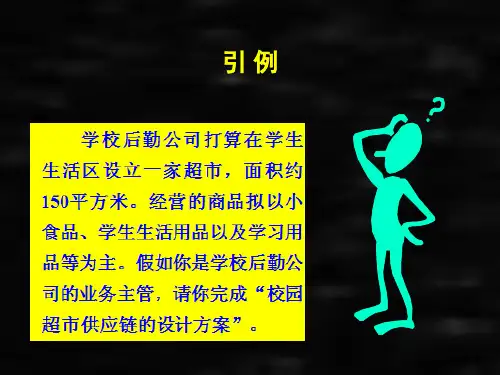
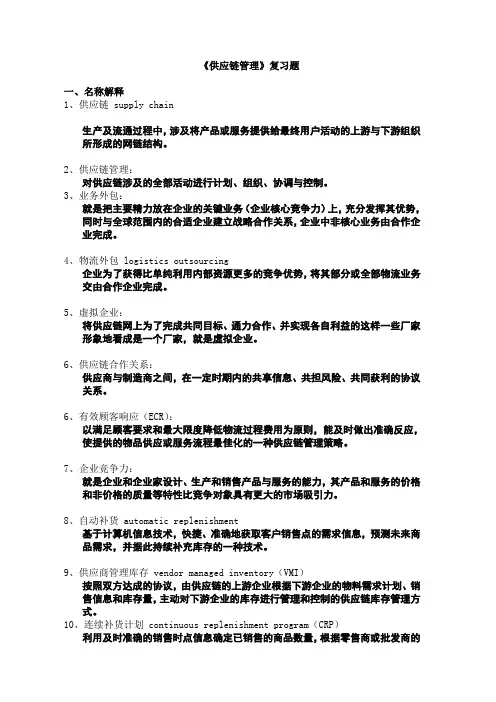
《供应链管理》复习题一、名称解释1、供应链 supply chain生产及流通过程中,涉及将产品或服务提供给最终用户活动的上游与下游组织所形成的网链结构。
2、供应链管理:对供应链涉及的全部活动进行计划、组织、协调与控制。
3、业务外包:就是把主要精力放在企业的关键业务(企业核心竞争力)上,充分发挥其优势,同时与全球范围内的合适企业建立战略合作关系,企业中非核心业务由合作企业完成。
4、物流外包 logistics outsourcing企业为了获得比单纯利用内部资源更多的竞争优势,将其部分或全部物流业务交由合作企业完成。
5、虚拟企业:将供应链网上为了完成共同目标、通力合作、并实现各自利益的这样一些厂家形象地看成是一个厂家,就是虚拟企业。
6、供应链合作关系:供应商与制造商之间,在一定时期内的共享信息、共担风险、共同获利的协议关系。
6、有效顾客响应(ECR):以满足顾客要求和最大限度降低物流过程费用为原则,能及时做出准确反应,使提供的物品供应或服务流程最佳化的一种供应链管理策略。
7、企业竞争力:就是企业和企业家设计、生产和销售产品与服务的能力,其产品和服务的价格和非价格的质量等特性比竞争对象具有更大的市场吸引力。
8、自动补货 automatic replenishment基于计算机信息技术,快捷、准确地获取客户销售点的需求信息,预测未来商品需求,并据此持续补充库存的一种技术。
9、供应商管理库存 vendor managed inventory(VMI)按照双方达成的协议,由供应链的上游企业根据下游企业的物料需求计划、销售信息和库存量,主动对下游企业的库存进行管理和控制的供应链库存管理方式。
10、连续补货计划 continuous replenishment program(CRP)利用及时准确的销售时点信息确定已销售的商品数量,根据零售商或批发商的库存信息和预先规定的库存补充程序确定发货补充数量和配送时间的计划方法。
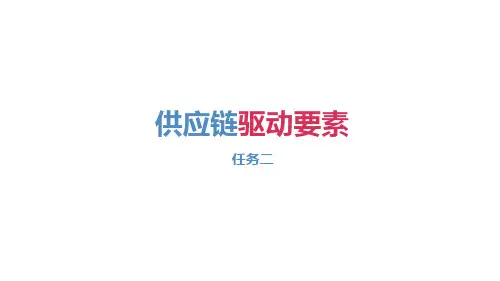
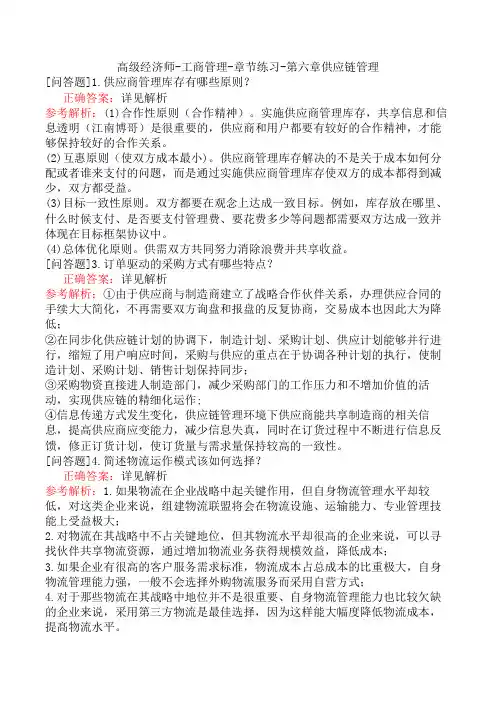
高级经济师-工商管理-章节练习-第六章供应链管理[问答题]1.供应商管理库存有哪些原则?正确答案:详见解析参考解析:(1)合作性原则(合作精神)。
实施供应商管理库存,共享信息和信息透明(江南博哥)是很重要的,供应商和用户都要有较好的合作精神,才能够保持较好的合作关系。
(2)互惠原则(使双方成本最小)。
供应商管理库存解决的不是关于成本如何分配或者谁来支付的问题,而是通过实施供应商管理库存使双方的成本都得到减少,双方都受益。
(3)目标一致性原则。
双方都要在观念上达成一致目标。
例如,库存放在哪里、什么时候支付、是否要支付管理费、要花费多少等问题都需要双方达成一致并体现在目标框架协议中。
(4)总体优化原则。
供需双方共同努力消除浪费并共享收益。
[问答题]3.订单驱动的采购方式有哪些特点?正确答案:详见解析参考解析:①由于供应商与制造商建立了战略合作伙伴关系,办理供应合同的手续大大简化,不再需要双方询盘和报盘的反复协商,交易成本也因此大为降低;②在同步化供应链计划的协调下,制造计划、采购计划、供应计划能够并行进行,缩短了用户响应时间,采购与供应的重点在于协调各种计划的执行,使制造计划、采购计划、销售计划保持同步;③采购物资直接进人制造部门,减少采购部门的工作压力和不增加价值的活动,实现供应链的精细化运作;④信息传递方式发生变化,供应链管理环境下供应商能共享制造商的相关信息,提高供应商应变能力,减少信息失真,同时在订货过程中不断进行信息反馈,修正订货计划,使订货量与需求量保持较高的一致性。
[问答题]4.简述物流运作模式该如何选择?正确答案:详见解析参考解析:1.如果物流在企业战略中起关键作用,但自身物流管理水平却较低,对这类企业来说,组建物流联盟将会在物流设施、运输能力、专业管理技能上受益极大;2.对物流在其战略中不占关键地位,但其物流水平却很高的企业来说,可以寻找伙伴共享物流资源,通过增加物流业务获得规模效益,降低成本;3.如果企业有很高的客户服务需求标准,物流成本占总成本的比重极大,自身物流管理能力强,一般不会选择外购物流服务而采用自营方式;4.对于那些物流在其战略中地位并不是很重要、自身物流管理能力也比较欠缺的企业来说,采用第三方物流是最佳选择,因为这样能大幅度降低物流成本,提髙物流水平。
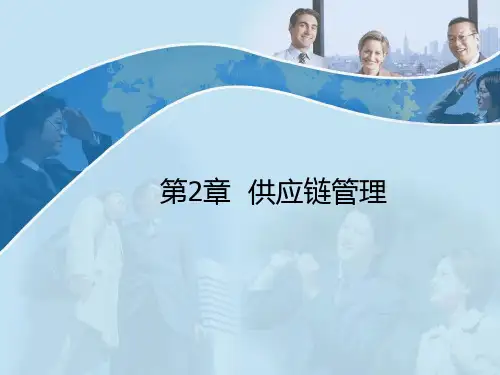
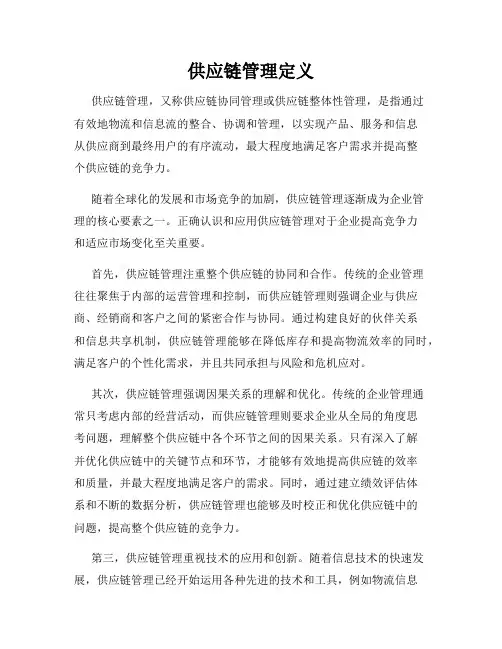
供应链管理定义供应链管理,又称供应链协同管理或供应链整体性管理,是指通过有效地物流和信息流的整合、协调和管理,以实现产品、服务和信息从供应商到最终用户的有序流动,最大程度地满足客户需求并提高整个供应链的竞争力。
随着全球化的发展和市场竞争的加剧,供应链管理逐渐成为企业管理的核心要素之一。
正确认识和应用供应链管理对于企业提高竞争力和适应市场变化至关重要。
首先,供应链管理注重整个供应链的协同和合作。
传统的企业管理往往聚焦于内部的运营管理和控制,而供应链管理则强调企业与供应商、经销商和客户之间的紧密合作与协同。
通过构建良好的伙伴关系和信息共享机制,供应链管理能够在降低库存和提高物流效率的同时,满足客户的个性化需求,并且共同承担与风险和危机应对。
其次,供应链管理强调因果关系的理解和优化。
传统的企业管理通常只考虑内部的经营活动,而供应链管理则要求企业从全局的角度思考问题,理解整个供应链中各个环节之间的因果关系。
只有深入了解并优化供应链中的关键节点和环节,才能够有效地提高供应链的效率和质量,并最大程度地满足客户的需求。
同时,通过建立绩效评估体系和不断的数据分析,供应链管理也能够及时校正和优化供应链中的问题,提高整个供应链的竞争力。
第三,供应链管理重视技术的应用和创新。
随着信息技术的快速发展,供应链管理已经开始运用各种先进的技术和工具,例如物流信息系统、物联网技术和大数据分析等,以提高供应链的运作效率和效果。
这些技术和工具不仅可以加快物流运输和信息传递的速度,还能够实时监控和优化供应链中的各个环节,并为决策者提供科学的依据。
通过技术的应用和创新,企业可以更好地理解和管理供应链,提高运营效率和决策质量。
最后,供应链管理是一个不断优化和改进的过程。
由于市场环境和客户需求的不断变化,供应链管理需要不断调整和改进,以适应市场的变化和挑战。
这个过程需要企业不断地学习和创新,与供应链中的各个环节保持密切的合作和沟通。
通过有效的学习和改进,企业可以更好地适应市场的竞争,提高供应链的响应速度和灵活性。
供应链管理的概念及基本原理供应链管理(Supply Chain Management,SCM)是一个全新、高效的企业管理模式。
它将企业与其供应商、分销商和客户之间的关系,结合为一个系统,从而形成了一种协调整个供应链、达到最佳运营状态的方式。
企业通过SCM,可更好地把握市场动态、实现供应链整合、提高效率降低成本、增强竞争力,以及快速响应市场需求等方面优势。
一、供应链管理的概念1.定义:供应链管理是指在整个供应链(包括供应商、企业、分销商和客户)中运用一系列现代企业管理方法和理论,通过信息共享、资源整合、协调配合、风险分享的方式,在现有的资源系统中实现对产品、信息和资金的有效整合,从而形成一整套始于原材料采购、到生产经营、到销售客户的一系列全过程管理。
2.特征:(1)全链条化:从供应商到终端用户整个过程都纳入到整个供应链的范围之内。
(2)共享化:信息、资源和责任等在供应链环节之间共享。
(3)协作化:供应链各环节之间协作共同完成产品服务的供给流。
(4)高效化:通过提高物流效率来降低整个供应链成本。
(5)完整化:供应链管理应该实现整个业务流程的全过程管理。
二、供应链管理的基本原理1.流程重组以客户为中心,将所有业务的流程、机制、技术建设、人员整合到一个系统之中。
构建完整的生产与供应链,从原材料采购到产品制造,再到流通销售和售后服务,打造全链条的供应链管理流程。
2.信息化建设信息化建设的意义是通过自动化提高信息的共享和协作。
如建立ERP、MES 等管理系统,强化物流系统的支持,进一步提高供应链管理效率。
3.组织优化组织优化是指通过内部各环节间的协调合作,从而实现供应链各环节间的协同作用,如申请财务的审批、库房管理与销售出库的协调,支持了更快捷的物流管理。
4.分供应商的选择选择合适的供应商有效的降低供应链成本,优先选择具备优势的价格、质量和交付时间的供应商,根据实际供应链的需求对供应商进行分层次、分领域的管理。
供应链管理的基本内容,效用及方法一,供应链管理1,供应链管理是一种集成的管理思想和方法,它执行供应链中从供应商到最终用户的物流的计划和控制等职能。
从单一的企业角度来看,是指企业通过改善上、下游供应链关系,整合和优化供应链中的信息流、物流、资金流,以获得企业的竞争优势。
2,供应链管理是企业的有效性管理,表现了企业在战略和战术上对企业整个作业流程的优化。
整合并优化了供应商、制造商、零售商的业务效率,使商品以正确的数量、正确的品质、在正确的地点、以正确的时间、最佳的成本进行生产和销售。
二,供应链管理的基本内容供应链管理包括计划、采购、制造、配送、退货五大基本内容。
1,计划:这是SCM的策略性部分。
你需要有一个策略来管理所有的资源,以满足客户对你的产品的需求。
好的计划是建立一系列的方法监控供应链,使它能够有效、低成本地为顾客递送高质量和高价值的产品或服务。
2,采购:选择能为你的产品和服务提供货品和服务的供应商,和供应商建立一套定价、配送和付款流程并创造方法监控和改善管理,并把对供应商提供的货品和服务的管理流程结合起来,包括提货、核实货单、转送货物到你的制造部门并批准对供应商的付款等。
3,制造:安排生产、测试、打包和准备送货所需的活动,是供应链中测量内容最多的部分,包括质量水平、产品产量和工人的生产效率等的测量。
4,配送:很多“圈内人”称之为“物流”,是调整用户的定单收据、建立仓库网络、派递送人员提货并送货到顾客手中、建立货品计价系统、接收付款。
5,退货:这是供应链中的问题处理部分。
建立网络接收客户退回的次品和多余产品,并在客户应用产品出问题时提供支持。
三,供应链管理的效用1,供应链优化的最终目的是满足客户需求,降低成本,实现利润,具体表现为:(1)提高客户满意度。
这是供应链管理与优化的最终目标,供应链管理和优化的一切方式方法,都是朝向这个目标而努力的,这个目标同时也是企业赖以生存的根本。
(2)提高企业管理水平。